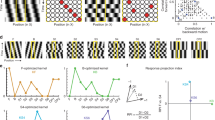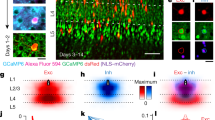Abstract
During development of the visual system, the pattern of visual inputs may have an instructive role in refining developing neural circuits1,2,3,4. How visual inputs of specific spatiotemporal patterns shape the circuit development remains largely unknown. We report here that, in the developing Xenopus retinotectal system, the receptive field of tectal neurons can be ‘trained’ to become direction-sensitive within minutes after repetitive exposure of the retina to moving bars in a particular direction. The induction of direction-sensitivity depends on the speed of the moving bar, can not be induced by random visual stimuli, and is accompanied by an asymmetric modification of the tectal neuron's receptive field. Furthermore, such training-induced changes require spiking of the tectal neuron and activation of a NMDA (N-methyl-d-aspartate) subtype of glutamate receptors during training, and are attributable to an activity-induced enhancement of glutamate-mediated inputs. Thus, developing neural circuits can be modified rapidly and specifically by visual inputs of defined spatiotemporal patterns, in a manner consistent with predictions based on spike-time-dependent synaptic modification.
This is a preview of subscription content, access via your institution
Access options
Subscribe to this journal
Receive 51 print issues and online access
$199.00 per year
only $3.90 per issue
Buy this article
- Purchase on Springer Link
- Instant access to full article PDF
Prices may be subject to local taxes which are calculated during checkout





Similar content being viewed by others
References
Wiesel, T. N. Postnatal development of the visual cortex and the influence of environment. Nature 299, 583–591 (1982)
Katz, L. C. & Shatz, C. J. Synaptic activity and the construction of cortical circuits. Science 274, 1133–1138 (1996)
Penn, A. A. & Shatz, C. J. Brain waves and brain wiring: the role of endogenous and sensory-driven neural activity in development. Pediatr. Res. 45, 447–458 (1999)
Zhang, L. I. & Poo, M. M. Electrical activity and development of neural circuits. Nature Neurosci. 4 Suppl., 1207–1214 (2001)
Hubel, D. H. & Wiesel, T. N. Binocular interaction in striate cortex of kittens reared with artificial squint. J. Neurophysiol. 28, 1041–1059 (1965)
Meister, M., Wong, R. O., Baylor, D. A. & Shatz, C. J. Synchronous bursts of action potentials in ganglion cells of the developing mammalian retina. Science 252, 939–943 (1991)
Penn, A. A., Riquelme, P. A., Feller, M. B. & Shatz, C. J. Competition in retinogeniculate patterning driven by spontaneous activity. Science 279, 2108–2112 (1998)
Cynader, M., Berman, N. & Hein, A. Cats reared in stroboscopic illumination: effects on receptive fields in visual cortex. Proc. Natl Acad. Sci. USA 70, 1353–1354 (1973)
Schmidt, J. T. & Eisele, L. E. Stroboscopic illumination and dark rearing block the sharpening of the regenerated retinotectal map in goldfish. Neuroscience 14, 535–546 (1985)
Weliky, M. & Katz, L. C. Disruption of orientation tuning in visual cortex by artificially correlated neuronal activity. Nature 386, 680–685 (1997)
Sharma, J., Angelucci, A. & Sur, M. Induction of visual orientation modules in auditory cortex. Nature 404, 841–847 (2000)
von Melchner, L., Pallas, S. L. & Sur, M. Visual behaviour mediated by retinal projections directed to the auditory pathway. Nature 404, 871–876 (2000)
Fregnac, Y., Shulz, D., Thorpe, S. & Bienenstock, E. A cellular analogue of visual cortical plasticity. Nature 333, 367–370 (1988)
Schuett, S., Bonhoeffer, T. & Hubener, M. Pairing-induced changes of orientation maps in cat visual cortex. Neuron 32, 325–337 (2001)
Gaze, R. M., Keating, M. J. & Chung, S. H. The evolution of the retinotectal map during development in Xenopus. Proc. R. Soc. London B 185, 301–330 (1974)
Holt, C. E. & Harris, W. A. Order in the initial retinotectal map in Xenopus: a new technique for labelling growing nerve fibres. Nature 301, 150–152 (1983)
Markram, H., Lübke, J., Frotscher, M. & Sakmann, B. Regulation of synaptic efficacy by coincidence of postsynaptic APs and EPSPs. Science 275, 213–215 (1997)
Zhang, L. I., Tao, H. W., Holt, C. E., Harris, W. A. & Poo, M. M. A critical window for cooperation and competition among developing retinotectal synapses. Nature 395, 37–44 (1998)
Feldman, D. E. Timing-based LTP and LTD at vertical inputs to layer II/III pyramidal cells in rat barrel cortex. Neuron 27, 45–56 (2000)
Boettiger, C. A. & Doupe, A. J. Developmentally restricted synaptic plasticity in a songbird nucleus required for song learning. Neuron 31, 809–818 (2001)
Abbott, L. F. & Blum, K. I. Functional significance of long-term potentiation for sequence learning and prediction. Cereb. Cortex 6, 406–416 (1996)
Zanker, J. M. & Zeil, J. Motion Vision—Computational, Neural, and Ecological Constraints (Springer, New York, 2000)
Rao, R. P. & Sejnowski, T. J. Predictive learning of temporal sequences in recurrent neocortical circuits. Novartis Found. Symp. 239, 208–229 (2001)
Roberts, P. D. Computational consequences of temporally asymmetric learning rules. I. Differential hebbian learning. J. Comput. Neurosci. 7, 235–246 (1999)
Mehta, M. R., Barnes, C. A. & McNaughton, B. L. Experience-dependent, asymmetric expansion of hippocampal place fields. Proc. Natl Acad. Sci. USA 94, 8918–8921 (1997)
Mehta, M. R., Quirk, M. C. & Wilson, M. A. Experience-dependent asymmetric shape of hippocampal receptive fields. Neuron 25, 707–715 (2000)
Bliss, T. V. P. & Collingridge, G. L. A synaptic model of memory: long-term potentiation in the hippocampus. Nature 361, 31–39 (1993)
Malenka, R. C. & Nicoll, R. A. Long-term potentiation—a decade of progress? Science 285, 1870–1874 (1999)
Zhang, L. I., Tao, H. & Poo, M. Visual input induces long-term potentiation of developing retinotectal synapses. Nature Neurosci. 3, 708–715 (2000)
Rae, J., Cooper, K., Gates, P. & Watsky, M. Low access resistance perforated patch recordings using amphotericin B. J. Neurosci. Methods 37, 15–26 (1991)
Acknowledgements
This work was supported by grants from NSF and NIH. F.E. was supported in part by a long-term fellowship from the Human Frontier Science Program.
Author information
Authors and Affiliations
Corresponding author
Ethics declarations
Competing interests
The authors declare that they have no competing financial interests.
Rights and permissions
About this article
Cite this article
Engert, F., Tao, H., Zhang, L. et al. Moving visual stimuli rapidly induce direction sensitivity of developing tectal neurons. Nature 419, 470–475 (2002). https://doi.org/10.1038/nature00988
Received:
Accepted:
Issue Date:
DOI: https://doi.org/10.1038/nature00988
This article is cited by
-
An Algorithm Based on a Cable-Nernst Planck Model Predicting Synaptic Activity throughout the Dendritic Arbor with Micron Specificity
Neuroinformatics (2023)
-
A deep convolutional visual encoding model of neuronal responses in the LGN
Brain Informatics (2021)
-
Experience-dependent development of visual sensitivity in larval zebrafish
Scientific Reports (2019)
-
GABAergic circuits control stimulus-instructed receptive field development in the optic tectum
Nature Neuroscience (2010)
-
Non-redundant odor coding by sister mitral cells revealed by light addressable glomeruli in the mouse
Nature Neuroscience (2010)
Comments
By submitting a comment you agree to abide by our Terms and Community Guidelines. If you find something abusive or that does not comply with our terms or guidelines please flag it as inappropriate.



